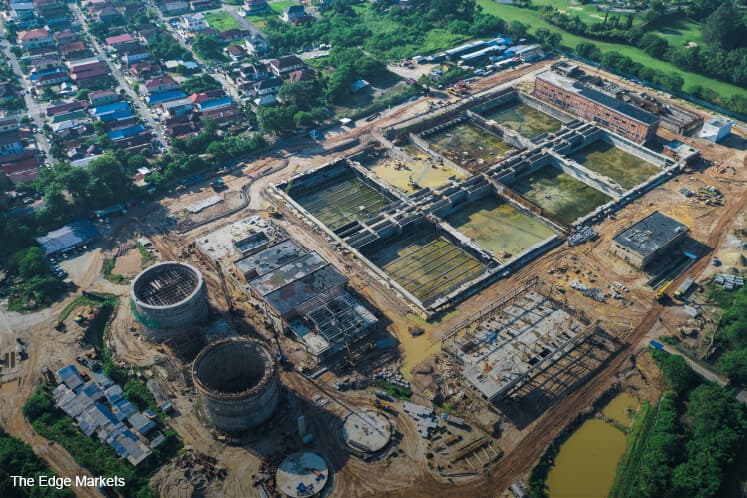
This article first appeared in The Edge Malaysia Weekly on May 29, 2017 - June 4, 2017
THE successful adoption and construction of Ekovest Bhd’s enhanced design for the Bunus sewerage treatment plant (STP) could be its launch pad into a new business segment, namely, a consultancy role to build efficient and innovative designs that lead to cost savings for institutions and governments.
On April 19, Ekovest announced that its wholly-owned subsidiary Ekovest KL Bund Sdn Bhd (EKLB) will receive an incentive from the government in respect of the Bunus STP. It will be payable to EKLB when its enhanced design for the Bunus STP delivers more than 20% cost savings on the final cost of the project and achieves the government’s key performance indicators under the incentive agreement.
The group says the adoption of the enhanced design could deliver cost savings of RM94.67 million, of which Ekovest will be entitled to RM71 million or 75%.
While the amount of the incentive is expected to be small compared to the group’s total revenue, the Bunus treatment plant will be a “model plant” that showcases its ability to help institutions and the government to cut costs through holistic planning and an innovative approach to alternative design.
Asked about potential interest from overseas for the group’s expertise, Datuk Seri Lim Keng Cheng, Ekovest managing director, says it intends to focus on Malaysia, adding that the successful construction of the enhanced design for the sewerage treatment plant will be a testament to the capabilities of local players in terms of planning and approach.

Lim says the alternative design allows the adoption of green technology
“Ekovest has gathered all the local experts ... in the field to work on this. The land use for the initial design is double [the size of] what we are using [in Bunus]. [This means] indirect savings for the government, which could better utilise the land earmarked for a treatment plant. With a smaller plant, we also save energy. This is an innovative design ... improving on the existing design that was proposed,” Lim tells The Edge.
He adds that Ekovest will be undertaking a similar enhancement job on the design of the Batu, Jinjang-Kepong STP, which will help the government save RM114.6 million.
The incentive to be paid to Ekovest for the enhancement of the two treatment plants will be capped at RM100 million. With total cost savings of RM209.27 million, the government could still see net savings of RM109.27 million, even after paying Ekovest’s incentive.
A portion of the incentive will be paid to Ekovest after the completion of the Bunus STP in September and the remainder once the construction work at the Batu, Jinjang-Kepong treatment plant is completed.
According to Lim, the Bunus and Batu, Jinjang-Kepong STPs are the two plants that Ekovest has identified as having potential for substantial savings.
“The total cost savings of the two plants is about RM209.27 million, but this does not take into account the land savings. The original design of the Bunus plant requires 19ha, the enhanced design proposal needs only 6.49ha. This will help the government to efficiently utilise the land bank earmarked for the treatment plant. The remaining land area of 12.51ha could be used for future expansion of the treatment plant,” he says.
Similarly, for the Batu, Jinjang-Kepong plant, the enhanced design will result in land savings of 77%, which allows future expansion. Lim adds that the proposed alternative design will also reduce the construction period to 36 months from 72 months.
“At the Batu, Jinjang-Kepong plant, the original design involves the relocation of squatters, while the alternative design will enable construction work to begin without ... major squatter issues,” Lim says.
He adds that the alternative design allows the adoption of green technology, such as gas energy generation and potential recycling of sludge.
“With this design, we also have a renewable energy [element], where the gas generated will be converted into energy and power for the plant’s usage,” Lim says.
Since the Bunus STP is part of the Greater Kuala Lumpur River of Life project, he says it is crucial to focus on increasing the capacity of the treatment plant through innovative engineering structure design in order to ensure sustainable growth.
In the first half ended Dec 31, 2016, some 77% of Ekovest’s total revenue of RM478.5 million came from the construction segment, while 14% and 9% were from its toll operations and property development respectively. With the Bunus plant expected to be completed by September this year, the contribution from the incentive gain is likely to only come in FY2018, and is not expected to be a significant contributor to the group’s total revenue.
In the last one month, Ekovest’s shares have been actively traded, swinging sharply between RM1.46 and RM1.17 following news of the collapse of the Bandar Malaysia deal. The group shares a common major shareholder with Iskandar Waterfront Holdings Sdn Bhd, the local partner in joint venture IWH-CREC Sdn Bhd, which was involved in the project.
Save by subscribing to us for your print and/or digital copy.
P/S: The Edge is also available on Apple's AppStore and Androids' Google Play.